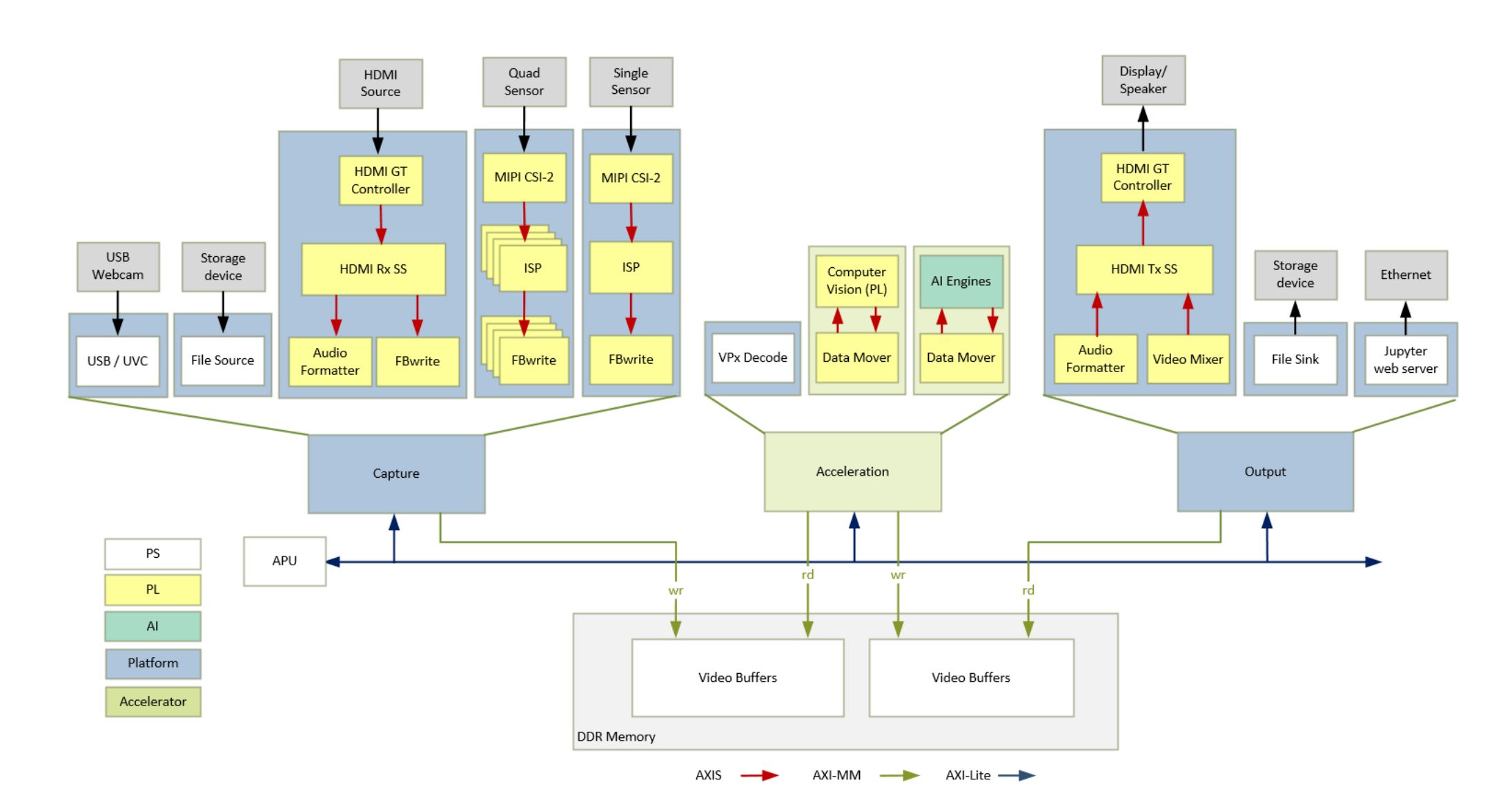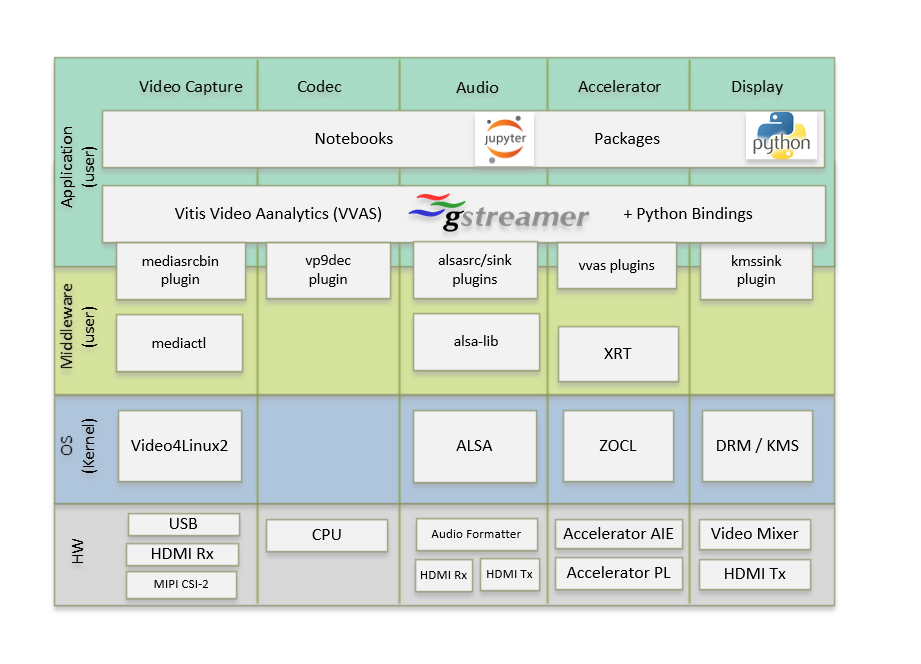2. Introduction¶
The Versal Base TRD consists of a series of platforms, accelerators and Jupyter notebooks to demonstrate various aspects of the design. A platform is a Vivado design with a pre-instantiated set of I/O interfaces and a corresponding PetaLinux BSP and image that includes the required kernel drivers and user-space libraries to exercise those interfaces. Accelerators are mapped to FPGA logic resources and/or AI Engine cores and stitched into the platform using the Vitis toolchain. The reference design currently supports the VCK190 evaluation board either with ES parts or production parts.
2.1. Platforms¶
The following is a list of supported platforms including key I/O interfaces:
Platform 1 - vck190_es1_mipiRxSingle_hdmiTx, vck190_mipiRxSingle_hdmiTx:
- Sources:
- USB webcam capture pipeline
- File source
- MIPI CSI-2 image sensor capture pipeline via FMC daughter card
- Processing:
- VP9 decode and demux
- 2D Filter (PL)
- 2D Filter (AIE)
- Sinks:
- HDMI Tx + video mixer display pipeline
- Application sink into jupyter notebook display
- Sources:
Platform 2 - vck190_es1_mipiRxQuad_hdmiTx, vck190_mipiRxQuad_hdmiTx:
Platform 2 is essentially an enhancement to platform 1 capture pipeline, while the rest of the hardware design and pre-instantiated set of I/O interfaces remain the same. The notable difference in the capture path is replacement of IMX274 image sensor with Avnet Multi-Camera image sensor.
Platform 3 - vck190_es1_hdmiRx_hdmiTx, vck190_hdmiRx_hdmiTx:
Platform 3 uses HDMI RX in the capture pipeline, while the rest of the hardware design and pre-instantiated set of I/O interfaces remain the same. HDMI RX also supports capture of audio data.
Audio replay can be done on all platforms. For Platform 1 and Plaform 2 the audio source is a file. In case of Platform 3 the audio source can be a either a file or HDMI RX.

2.2. Software Stack¶
The main software frameworks used in this reference design are:
- Jupyter notebooks for top-level application control and visualization
- GStreamer multimedia framework and plugins for video pipeline creation
- V4L2 kernel subsystem and drivers for video capture devices
- Xilinx run-time (XRT) and Xilinx OpenCL for acceleration kernels
- DRM/KMS kernel subsystem and drivers for display devices
- ALSA kernel subsystem and drivers for audio devices
Working of above frameworks are detailed in Chapter 9.

2.3. Design Files¶
The design source files are available at https://github.com/Xilinx/vck190-base-trd.git It has the following contents:
- Petalinux Board Support Package (BSP)
- Vivado hardware platform projects
- Vitis accelerator overlay projects
- HTML Documentation sources
- README file
The design file hierarchy is shown below:
vck190-base-trd
├── docs
├── overlays
│ ├── filter2d
│ │ ├── apps
│ │ │ └── filter2d-notebooks
│ │ └── kernels
│ │ ├── filter2d_aie
│ │ ├── filter2d_combined
│ │ └── filter2d_pl
│ ├── Vitis_Libraries
│ │ └── vision
│ └── xvdpu
│ ├── apps
│ │ └── smart-mipi-app
│ └── kernels
│ ├── vitis_prj
│ └── xvdpu_ip
├── petalinux
│ └── xilinx-vck190-base-trd
├── platforms
│ ├── scripts
│ └── vivado
│ ├── ip
│ ├── vck190_es1_hdmiRx_hdmiTx
│ ├── vck190_es1_mipiRxQuad_hdmiTx
│ ├── vck190_es1_mipiRxSingle_hdmiTx
│ ├── vck190_hdmiRx_hdmiTx
│ ├── vck190_mipiRxQuad_hdmiTx
│ └── vck190_mipiRxSingle_hdmiTx
└── README.md
In the following tutorials, it is assumed that the design source files are cloned
into a directory referred to as $working_dir, e.g.
export working_dir=/path/to/cloned/repo/vck190-base-trd
2.4. Licenses¶
The design includes files licensed by Xilinx and third parties under the terms of the GNU General Public License, GNU Lesser General Public License, BSD License, MIT License, and other licenses. The file vck190_base_trd_third_party_licenses_and_source.tar.gz contains the complete set of design source files and licenses. You are solely responsible for checking any files you use for notices and licenses and for complying with any terms applicable to your use of the design and any third party files supplied with the design.
Licensed under the Apache License, Version 2.0 (the “License”); you may not use this file except in compliance with the License.
You may obtain a copy of the License at [http://www.apache.org/licenses/LICENSE-2.0](http://www.apache.org/licenses/LICENSE-2.0)
Unless required by applicable law or agreed to in writing, software distributed under the License is distributed on an “AS IS” BASIS, WITHOUT WARRANTIES OR CONDITIONS OF ANY KIND, either express or implied. See the License for the specific language governing permissions and limitations under the License.